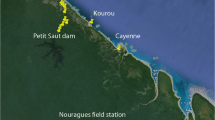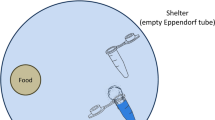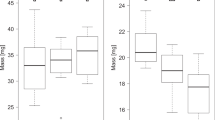Abstract
Phthalates are common atmospheric contaminants used in the plastic industry. Ants have been shown to constitute good bioindicators of phthalate pollution. Hence, phthalates remain trapped on ant cuticles which are mostly coated with long-chain hydrocarbons. In this study, we artificially contaminated Lasius niger ants with four phthalates: dibutyl phthalate (DBP), diisobutyl phthalate (DiBP), di(2-ethylhexyl) phthalate (DEHP), and benzyl butyl phthalate (BBP). The first three have previously been found on ants in nature in Touraine (France), while the fourth has not. The four phthalates disappeared rapidly (less than 5 days) from the cuticles of live ants. In contrast, on the cuticles of dead ants, DEHP quantities remained unchanged over time. These results indicate that phthalates are actively absorbed by the cuticles of live ants. Cuticular absorption of phthalates is nonspecific because eicosane, a nonnatural hydrocarbon on L. niger cuticle, was similarly absorbed. Ants are important ecological engineers and may serve as bioindicators of ecosystem health. We also suggest that ants and more generally terrestrial arthropods may contribute to the removal of phthalates from the local environment.



Similar content being viewed by others
References
Abril S, Gómez C (2013) Rapid assessment of ant assemblages in public pine forests of the central Iberian Peninsula. For Ecol Manag 293:79–84
Albro PW, Corbett JT, Schroeder JL (1993) The metabolism of di-(2-ethylhexyl) phthalate in the earthworm Lumbricus terrestris. Comp Biochem Physiol C Pharmacol Toxicol Endocrinol 104:335–344
Bagnères AG, Blomquist GJ (2010) Site of synthesis, mechanism of transport and selective deposition of hydrocarbons. In: G. J. Blomquist and A. G. Bagnères (Eds), Insect hydrocarbons. Biology, biochemistry, and chemical ecology. Cambridge University Press, pp 75–99
Blanchard M, Teil M-J, Dargnat C, Alliot F, Chevreuil M (2013) Assessment of adult human exposure to phthalate esters in the Urban Centre of Paris (France). Bull Environ Contam Toxicol 90:91–96
Bono-Blay F, Guart A, de la Fuente B, Pedemonte M, Pastor MC, Borrell A, Lacorte S (2012) Survey of phthalates, alkylphenols, bisphenol A and herbicides in Spanish source waters intended for bottling. Environ Sci Pollut Res 19:3339–3349
Cecinato A, Balducci C, Mastroianni D, Perilli M (2012) Sampling and analytical methods for assessing the levels of organic pollutants in the atmosphere: PAH, phthalates and psychotropic substances: a short review. Environ Sci Pollut Res 19:1915–1926
Chen L, Zhao Y, Li L, Chen B, Zhang Y (2012) Exposure assessment of phthalates in non-occupational populations in China. Sci Total Environ 427–8:60–69
Colborn T (1998) Endocrine disruption from environmental toxicants. In: Rom WN (ed) Environmental and occupational medecine. Lippincott-Raven, Philadelphia, pp 807–816
Cuvillier-Hot V, Salin K, Devers S, Tasiemski A, Schaffner P, Boulay R, Billiard S, Lenoir A (2014) Impact of ecological doses of the most widespread phthalate on a terrestrial species, the ant Lasius niger. 131:104–110
El Haddad I, Marchand N, Dron J, Temime-Roussel B, Quivet E, Wortham H, Jaffrezo JL, Baduel C, Voisin D, Besombes JL, Gille G (2009) Comprehensive primary particulate organic characterization of vehicular exhaust emissions in France. Atmos Environ 43:6190–6198
European Environment Agency E E A (2012) The impacts of endocrine disrupters on wildlife, people and their environments Luxembourg: publications of the European Union
Gaudin R, Marsan P, Ndaw S, Robert A, Ducos P (2011) Biological monitoring of exposure to di(2-ethylhexyl) phthalate in six French factories: a field study. Int Arch Occup Environ Health 84:523–531
Gaylor MO, Harvey E, Hale RC (2012) House crickets can accumulate polybrominated diphenyl ethers (PBDEs) directly from polyurethane foam common in consumer products. Chemosphere 86:500–505
Gramigni E, Calusi S, Gelli N, Giuntini L, Massi M, Delfino G, Chelazzi G, Baracchi D, Frizzi F, Santini G (2013) Ants as bioaccumulators of metals from soils: Body content and tissue-specific distribution of metals in the ant Crematogaster scutellaris. Eur J Soil Biol, in press
Hale RC, La Guardia MJ, Harvey E, Matt Mainor T (2002) Potential role of fire retardant-treated polyurethane foam as a source of brominated diphenyl ethers to the US environment. Chemosphere 46:729–735
Heudorf U, Mersch-Sundermann V, Angerer E (2007) Phthalates: toxicology and exposure. Int J Hyg Environ Health 210:623–634
Hu X-y, Wen B, Zhang S, X-q S (2005) Bioavailability of phthalate congeners to earthworms (Eisenia fetida) in artificially contaminated soils. Ecotoxicol Environ Saf 62:26–34
Jen J-F, Liu T-C (2006) Determination of phthalate esters from food-contacted materials by on-line microdialysis and liquid chromatography. J Chrom A 1130:28–33
Jensen J, van Langevelde J, Pritzl G, Krogh PH (2001) Effects of di(2-ethylhexyl) phthalate and dibutyl phthalate on the collembolan Folsomia fimetaria. Environ Toxicol Chem 20:1085–1091
Keyser P, Pujar BG, Eaton RW, Ribbons DW (1976) Biodegradation of phthalates and their esters by bacteria. Environ Health Perspect 18:159–166
Koch HM, Calafat AM (2009) Human body burdens of chemicals used in plastic manufacture. Philos Trans R Soc B Biol Sci 364:2063–2078
Lenoir A, Fresneau D, Errard C, Hefetz A (1999) The individuality and the colonial identity in ants: the emergence of the social representation concept. In: Detrain C, Deneubourg JL, Pasteels J (eds) Information processing in social insects. Birkhäuser Verlag, Basel, pp 219–237
Lenoir A, Depickère S, Devers S, Christidès J-P, Detrain C (2009) Hydrocarbons in the ant Lasius niger: from the cuticle to the nest and home range marking. J Chem Ecol 35:913–921
Lenoir A, Cuvillier-Hot V, Devers S, Christidès J-P, Montigny F (2012) Ant cuticles: a trap for atmospheric phthalate contaminants. Sci Total Environ 441:209–212
Liang DW, Zhang T, Fang HHP, He JZ (2008) Phthalates biodegradation in the environment. Appl Microbiol Biotechnol 80:183–198
Majer JD (2009) Animals in the restoration process-progressing the trends. Restor Ecol 17:315–319
Marlier JF, Quinet Y, de Biseau JC (2004) Defensive behaviour and biological activities of the abdominal secretion in the ant Crematogaster scutellaris (Hymenoptera:Myrmicinae). Behav Process 67:427–440
Meskali M, Bonavita-Cougourdan A, Provost E, Bagnères A-G, Dusticier G, Clément J-L (1995) Mechanism underlying cuticular hydrocarbon homogeneity in the ant Camponotus vagus (Scop.) (Hymenoptera:Formicidae): role of postpharyngeal glands. J Chem Ecol 21:1127–1148
Migula P, Nuorteva P, Nuorteva S L, Glowacka E, Oja A (1993) Physiological disturbances in ants (Formica aquilonia) from excess of cadmium and mercury in a Finnish forest. 134(Supplement 2):1305–1314
Oehlmann J, Schulte-Oehlmann U, Kloas W, Jagnytsch O, Lutz I, Kusk KO, Wollenberger L, Santos EM, Paull GC, Van Look KJW, Tyler CR (2009) A critical analysis of the biological impacts of plasticizers on wildlife. Philos Trans R Soc B Biol Sci 364:2047–2062
Olujimi OO, Fatoki OS, Odendaal JP, Okonkwo JO (2010) Endocrine disrupting chemicals (phenols and phthalates) in the South African environment: a need for more monitoring. Water SA 36:671–682
Ran D, Cai S, Wu H, Gu H (2012) Di (2-ethylhexyl) phthalate modulates cholinergic mini-presynaptic transmission of projection neurons in Drosophila antennal lobe. 50:3291–3297
Semenova TA, Belozerskii MA, Belyakova GA, Borisov BA, Semenova SA, Dunaevskii YE (2011) Secreted protease of the entomopathogenic fungus Cordyceps militaris. II. Enzyme properties and adsorption on the insect cuticle. Microbiology 80:889–892
Sioen I, Fierens T, Van Holderbeke M, Geerts L, Bellemans M, De Maeyer M, Servaes K, Vanermen G, Boon PE, De Henauw S (2012) Phthalates dietary exposure and food sources for Belgian preschool children and adults. Environ Int 48:102–108
Staples CA, Peterson DR, Parkerton TF, Adams WJ (1997) The environmental fate of phthalate esters: a litterature review. Chemosphere 35:667–749
Teil MJ, Blanchard M, Chevreuil M (2006) Atmospheric fate of phthalate esters in an urban area (Paris-France). Sci Total Environ 354:212–223
Teil MJ, Tlili K, Blanchard M, Chevreuil M, Alliot F, Labadie P (2012) Occurrence of polybrominated diphenyl ethers, polychlorinated biphenyls, and phthalates in freshwater fish from the Orge River (Ile-de France). Arch Environ Contam Toxicol 63:101–113
Vauchot B, Provost E, Bagnères A-G, Rivière G, Roux M, Clément J-L (1998) Differential adsorption of allospecific hydrocarbons by cuticles of two termite species, Reticulitermes santonensis and R. lucifugus grassei, living in mixed colony. J Insect Physiol 44:59–66
Wang WX, Zhang YL, Wang SL, Fan CBQ, Xu H (2012) Distributions of phthalic esters carried by total suspended particulates in Nanjing, China. Environ Monit Assess 184:6789–6798
Yuan S-Y, Huang IC, Chang B-V (2010) Biodegradation of dibutyl phthalate and di-(2-ethylhexyl) phthalate and microbial community changes in mangrove sediment. J Hazard Mater 184:826–831
Acknowledgments
We thank Guy Bourdais, who helped with the rearing of the ants. Frédéric Montigny provided some of the phthalates and verified the absence of phthalates in polystyrene boxes. Jessica Pearce corrected the English. Thanks to a reviewer who helped to clarify and improve the text.
Author information
Authors and Affiliations
Corresponding author
Additional information
Responsible editor: Philippe Garrigues
Rights and permissions
About this article
Cite this article
Lenoir, A., Touchard, A., Devers, S. et al. Ant cuticular response to phthalate pollution. Environ Sci Pollut Res 21, 13446–13451 (2014). https://doi.org/10.1007/s11356-014-3272-2
Received:
Accepted:
Published:
Issue Date:
DOI: https://doi.org/10.1007/s11356-014-3272-2




